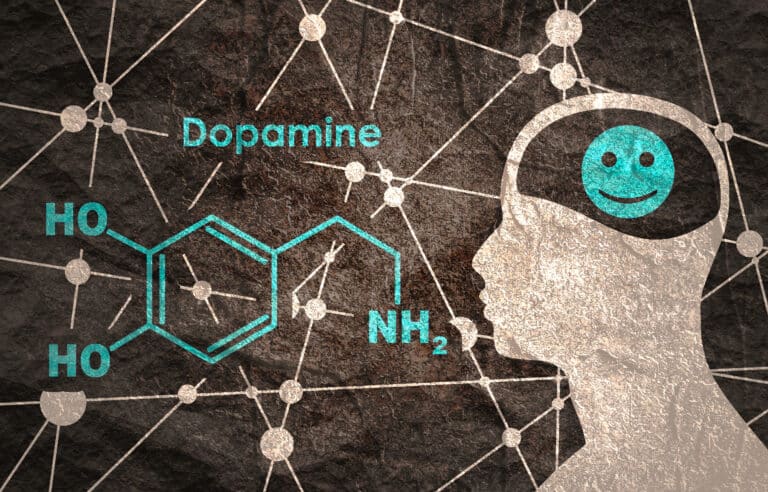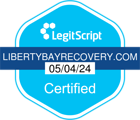You may have heard about dopamine, the feel-good hormone in our brains. But few people understand the depth of dopamine’s connection to substance abuse and addiction. This natural chemical is a neurotransmitter that travels along four major pathways in the brain and body, carrying signals related to our thoughts, feelings, and movements. Dopamine’s signaling along one of these pathways, the mesolimbic pathway, responds to drug use. This “reward pathway” motivates some behaviors closely tied to survival instincts.
Terms like neurotransmitters, the ideas of dopamine circuits, and the mesolimbic pathway can sound overwhelming. Simply put, addictive substances cause dopamine to flood the reward pathway creating surges of pleasure or “dopamine rushes,” ten times more powerful than any naturally occurring reward. These good feelings make you want to use your drug more, leading to addiction. At the same time, the ongoing surge of dopamine changes how the brain is wired, making it more difficult to stop using substances. When you try to quit your substance use, you struggle because of the ill feelings of withdrawal experienced in the absence of the dopamine surge.
As we dig deeper into the dopamine pathway and how it relates to substance use, remember that you are not alone in your journey to stop abusing drugs or alcohol. Despite the dopamine surge, you can quit your substance use and start a new life of greater productivity, happiness, and wellness. The key is seeking help from qualified professionals who understand the science of addiction and how to overcome it safely. You can find these professionals at Liberty Bay Recovery Center in Portland, Maine. The good news is that the brain is a miraculous organ; without the effects of drugs and alcohol, it can rewire itself and return to a healthy balance.
Drugs and the Dopamine Pathway
Each drug works differently in the brain and body. But all commonly abused substances affect the mesolimbic dopamine pathway, or reward circuit, by increasing dopamine levels in the brain. Drugs and alcohol are not the only substances leading to dopamine surges along this circuit. The same effects occur for all addictive substances and compulsions, such as:
- Heroin
- Cocaine
- Methamphetamine
- Opioids
- Alcohol
- Tobacco
- Eating Disorders
- Gambling
- Compulsive Exercise
- Sex Addiction
The mesolimbic dopamine pathway controls motivated behaviors and drives continued drug use even when you know it is bad for you. Scientists only discovered this critical connection between substance abuse and the brain within the last 50 years. They labeled the section of the brain affected by drugs and alcohol as the brain reward region in humans and other animals.
You continue using drugs or drinking because your brain rewards you. The dopamine pathway carries the reward signals with each use, such as feeling warm, calm, energized, satisfied, social, or otherwise pleased. However, when you do not use substances, you experience unpleasant feelings that drive you into drug-seeking behaviors. This is much like the cycle of eating food, feeling satisfied, then feeling hungry for more.
Although it sounds like science fiction, the reward circuit and its stimulation by drugs and alcohol are visible in imaging studies. Scientists describe it as being like a traffic hub with many signals. The circuitry is the dopamine pathway, and the signals are the dopamine surges influenced by the substances you take. This pathway is embedded in the part of your brain that sits atop the brainstem. This is the midbrain, a section developed about 500 million years ago in vertebrates. From the midbrain, the circuitry travels toward the front of the brain.
How an Addicted Brain Works
Drugs, alcohol, or other addictive behaviors cause dopamine surges along the mesolimbic pathway, driving a desire to continue the feeling. But what does addiction do to the brain?
Physical and Chemical Changes
According to scientists, addiction physically changes and rewires the brain, particularly along the dopamine pathway. Although addiction is now commonly called substance use disorder (SUD), it is defined as a chronic brain disease. It is not a matter of self-control or making up your mind. However, like other chronic diseases, such as asthma, heart disease, or diabetes, addiction can be treated with the help of professionals.
Prolonged substance abuse can have additional adverse effects on the brain. Memory, concentration, and the ability to learn are all impacted by substance abuse. In addition, you make bad decisions and exercise poor judgment because of physical and chemical changes in your brain. Even when you want to quit, breaking the drug-seeking and using cycle can seem impossible.
Tolerance
Each use causes the brain to associate the dopamine rush with the substance. Eventually, this association will override the brain’s natural ability to feel pleasure. As the substance takes control of the brain, the reward center becomes overstimulated, and the pathways are overwhelmed. Making it difficult for the brain to handle the floods of dopamine. As a result, the brain desensitizes, and the effect of the substance decreases. This tolerance makes getting high harder and harder.
Because of tolerance and reduced dopamine sensitivity, feeling natural pleasure becomes more difficult without substances. As a result, you feel more compelled to get high again to feel happy or satisfied. But because of tolerance in the brain, you need higher and higher doses. Drug cravings also begin. This is why people use the drug more often or in more significant amounts than ever. It is the slippery slope to serious addiction.
Making the Recovery Journey Easier
According to the National Institute on Drug Abuse (NIDA), more is known about how drugs affect the brain than any other brain science. This advanced knowledge benefits anyone seeking addiction recovery. For example, medical detox centers like Liberty Bay Recovery Center use evidence-based methods to make withdrawal easier for clients ending their substance abuse. These methods help the brain heal and restore healthy balance along the dopamine pathway.
This does not mean that addiction recovery is easy. Some neurological changes last longer than others. One such change is an ongoing vulnerability to addictive substances through relapse. That vulnerability proves why rehab treatment is so critical after detox.
Because medical detox centers understand withdrawal better than ever, this process is more comfortable than in decades past. Detox centers provide what the brain and body need to ease the transition from physical dependence to sobriety. This support includes personal comforts, security, nutritious meals, hydration, supervision, therapy, and medications. Of course, precise methods vary from one detox center to the next. But medical detox is the safest pathway for clients seeking to end their drug or alcohol abuse.
Alcohol Withdrawal
Alcohol withdrawal symptoms treated in medical detox include:
- Anxiety
- Irritability
- Sleeplessness
- Restlessness
- Nightmares
- Sweating
- Fast heart rate
- High blood pressure
- Nausea or vomiting
- Hand tremors
- Delirium Tremens
- Seizures
- Hallucinations
Some alcohol withdrawal symptoms, such as delirium tremens, and seizures, require immediate medical attention. Being in a medical detox center provides access to licensed healthcare professionals, making it a much safer environment than non-medical detox or at-home “cold turkey” withdrawal.
Drug-Specific Withdrawal
Withdrawal symptoms vary depending on the drug or drugs being used and other factors. Common symptoms treated as part of drug detox in a medical detox center include:
- Insomnia
- Mood swings
- Irritability
- Anxiety
- Depression
- Aches and pains
- Nausea
- Fatigue
- Hot and cold flashes
- Fever and chills
- Runny nose
- Teary eyes
- Hallucinations
- Paranoia
- Confusion
- Tremors
As with alcohol withdrawal, some of these symptoms can require immediate medical attention. Emergency healthcare is accessible in a medical detox center.
Re-Establishing Homeostasis in the Brain after Addiction
Addiction recovery involves re-establishing homeostasis, or healthy balance, within the brain and its dopamine pathway. While this process begins with detox, achieving this will take far longer than seven to 14 days. While detox helps the brain start healing physically, there are also emotional and cognitive effects of long-term substance abuse. These effects are treated in a rehab program.
Drug and Alcohol Treatment Programs
Types of rehab programs include:
- Residential Inpatient Rehab
- Partial Hospitalization Program (PHP)
- Intensive Outpatient Program (IOP)
Addiction Treatment Therapies
In rehab treatment, recovering clients have access to an array of therapies, like:
- Cognitive Behavioral Therapy (CBT)
- Individual and Group Therapy
- Dialectical Behavior Therapy (DBT)
- Addiction Education
- Seeking Safety
- Trauma Therapy
- Relapse Prevention
Behavioral and trauma therapies like cognitive behavioral therapy (CBT), dialectical behavior therapy (DBT), motivational interviewing, eye movement desensitization and reprocessing (EMDR), and contingency management prove especially helpful for recovery from substance use disorders. Each therapy type helps return homeostasis to the brain’s dopamine pathway.
Heal Your Brain and Put Addiction Behind You
The brain and its dopamine pathways play a crucial role in addiction. Still, despite your substance use disorder being a chronic disease, you can put your addiction behind you through effective treatment programs, such as medical detox and rehab. The brain is our most amazing organ and is unmatched in its ability to return to a healthy balance. You can start achieving that healthy balance by making your first call to a medical detox center or rehab program.






